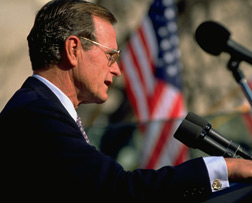“We were trying to make a difference in peoples’ lives for the short amount of time they were going to be around,” says Jeff Cheek, Associate to the Chairman, Board of Commissioners, Fulton County, speaking of the early days of the Ryan White Title I (now Part A) Program. Cheek, who has worked for the Atlanta Title I grantee’s office since 1992, says, “We weren’t thinking about sustaining programs, just getting money out on the street to make a difference.”1
His recollections echo those of others at HRSA and in local communities as they launched the new Federal initiative in the Nation’s urban centers hardest hit by HIV. In that era, myths and fears about the disease were rampant, and gay community newspapers were filled with pages upon pages of obituaries.
“It was a volcano of emotion and passion,” remembers Theresa Fiaño,2 who worked in Seattle in the years before the Ryan White Program and helped launch that city’s Title I program. “The people I worked with were mostly there for the same reasons I was. We all knew someone who was affected, and [we] wanted to do something, whatever we could. We didn’t see an end in sight, but at the same time we thought something had to come around the bend.”
“It was truly an incredible time, the energy was incredible,” says HRSA’s Sheila McCarthy.3 “There were not that many of us, not more than 30 people working on AIDS programs at HRSA at the time the legislation was passed, and we had the feeling that we would be able to do something to make a difference, and there was just extraordinary need.”
In all the original 16 Title I communities (known as Eligible Metropolitan Areas, or EMAs) funded in FY 1991, Ryan White Comprehensive AIDS Resources Emergency (CARE) Act programs were built on the foundations of existing public and private initiatives. HRSA’s AIDS Service Demonstration Grants and the Robert Wood Johnson (RWJ) Foundation’s AIDS Health Services Program were launched in 1986 to support community-based care networks in urban communities that were grappling with how best to respond to the new and growing epidemic.
View the list of urban communities receiving EMA funding. (PDF – 68.2 KB)
A Time of Critical Need
These programs were launched at a time when people with AIDS often required extensive medical and support services, despite high fatality rates and short life expectancies. Hospitals in communities with relatively large caseloads were especially strained by the lack of out-of-hospital placement options.4 “They were filling up hospitals in New York, but there was no back door; there was nowhere to send them,” says Mervyn Silverman, who served as director of public health in San Francisco and went on to run the RWJ program.5 His observation reflected what HRSA was finding in communities across the country: The critical challenge was “coordinating medical and related services into a system of care.”6
“There were . . . not more than 30 people working on AIDS programs at HRSA at the time the legislation was passed, and we had the feeling that we would be able to do something to make a difference.”
—Sheila McCarthy
“It was a volcano of emotion and passion. . . . The people I worked with were there for the same reasons I was. We all knew someone who was affected, and [we] wanted to do something, whatever we could.”
—Theresa Fiaño
Drawing on Community Efforts
Recognizing that many communities had taken steps to structure such care, HRSA designed the demonstration grants to support and strengthen existing efforts. The HRSA project funded 4 communities in its inaugural year, which grew to 25 in its final year, FY 1990. Total annual funding for all the communities grew from $10 million to $17.2 million 5 years later.





